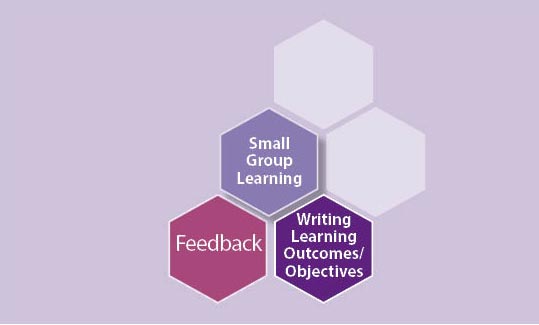Introduction
One the main reasons that we employ small group activities is to help students engage in deep learning (See the CORAL Cell, Surface and Deep Learning). Small group discussions are not short cuts to acquiring or memorizing core knowledge (See CORAL Cell Bloom's Taxonomy: Cognitive Domain). By solving problems and engaging in application exercises with other learners, students are encouraged, inspired, and supported in thinking more deeply about what they are learning.
Another important purpose of working in small group is to help students learn and practice essential skills they need for the remainder of their careers. The time and effort we invest in equipping students with the skills to make groups successful will carry forward. The key ingredients you will soon read about create successful small group learning which can then be directly applied to work within the clinical environment with teams of physicians, students, inter-professional health care providers and more. The ingredients that make small learning groups work well also make teams successful.
Not all case discussion or journal club small groups work well. Different individuals bring different skills, knowledge, and attitudes to the group. This can affect how well groups work or don't work together, and how much learning takes place during group interaction. It can also affect the satisfaction of the teacher/facilitator. We often cannot control who comes to a group session. Nor are many teachers aware of or able to maximize group success. In this CORAL Cell you are going to learn why some groups fail and others succeed, why some are more successful, and others are much less so. There are ways to organize small groups that can help make them successful. Armed with this understanding and equipped with a few skills, after you complete this CORAL Cell you will be better able to organize and facilitate small groups.
Learning Outcomes for this CORAL Cell on effective small group facilitation
(what you can reasonably expect to learn in the next 15 minutes):
- Describe the five key ingredients of successful small groups (cooperative learning).
- Given a brief scenario, identify the ingredients of cooperative learning apparent in the fictional small group situation.
- Given a brief scenario that is missing one or more of the ingredients of cooperative learning, explain how to re-design the small group work to incorporate the missing principle (s)
To what extent are you now able to meet these outcomes? Please record your self-assessments. (1 is not at all and 5 is completely)
Before we get started, describe a time when small group work did and/or did not work (you were a learner or teacher). What do you think contributed to the group's success/lack of success?
Learning about successful small groups
Ingredients for Cooperative Learning (CL)
Using Cooperative Learning (CL) is one way to scaffold a successful group learning interaction. Cooperative learning is small groups of students working together, for one class period to several weeks, to learn together and complete specific tasks and assignments together (Johnson, Johnson, & Holubec, 2008). Best practice CL has five important and necessary ingredients or key features: positive interdependence, face-to-face promotive interaction, individual accountability, interpersonal and small-group skills, and group processing (Johnson et al., 1998; Nilson, 1998). Many descriptions of successful interdisciplinary learning found in the literature include at least some of these features, though they may not be identified by name (Parsell & Bligh, 1998).

Positive interdependence means being authentically interconnected with the other members of the group. The students strive together to reach a common goal or share resources or have roles that complement each other. A common goal might be the completion of a project or task such as a patient problem or public health dilemma presented on paper or in person. Without positive interdependence, members of the group cannot make a unique contribution; they are redundant. Members may fade out or away as they notice they are not needed. This is likely the most important ingredient for success.
Face-to-face promotive interaction means close, usually synchronous, purposeful activity such as discussion, debate and joint decision-making (not declarative piecemeal research) where members help each other to succeed. In the absence of this (relatively) intense interaction, members are not drawn into the activity where the other element can be established.

Individual and group accountability means that each member is tested for the mastery of the material and is held responsible for contributing a fair share to the success of the group. It is an important factor because it stipulates that no one can opt out of learning or be allowed to hide behind the work of others. Groups lacking individual accountability, members may fail to invest in the process and hitchhike on the work and efforts of others.
Interpersonal and small-group skills involve teaching members the team skills needed to succeed: showing respect, being inclusive, sharing leadership, speaking up, and dealing with interpersonal and substantive conflicts. If we neglected this interactional element, students may not grow in their skills and understanding. For example, they may labor under the misconception that all conflict is bad and realize too late about the difference between conflict that is personal and destructive and conflict that is substantive and often leads to better decisions.
Group processing means group members analyze their actions (both group and individual) that contributed (or not) to the effectiveness of the group process and decide what to do or not do about it in their collective and individual futures. When groups, students or practicing professionals neglect examining their practices and debriefing, they miss the opportunity to address issues early enough to prevent dysfunctional interactions.
Below, we describe a small group activity that we find to be very effective; the "jigsaw" method. We will point out the key features of cooperative learning that are embodied in this activity as a means to demonstrate and reinforce these ingredients.
Students are assigned one of four or five articles to read or podcasts to listen to (positive interdependence). When they get to class, they are instructed to practice especially one skill of teams such as asking for clarification and offering opinions and insights or encouraging each other (interpersonal skills). They first form small groups of students who had read the same article and they ensure that they understand the main points in preparation for teaching their classmates who had not read that article (individual accountability, promotive interaction). Then, students form mixed groups (student had read different articles) and they discuss an issue or try to solve a problem for which each of the various articles provides a different resource or perspective (promotive interaction, positive interdependence). For example, I used this activity to discuss whether Osler was a good role model for medical students today. Before the group disbands, they explain to each other what went well and how the learning experience might be better (group processing) next time. After students return to their own spaces, each student provides a summary of the discussion highlighting key points (individual accountability).
Check for Understanding
Each question is associated with the correspondingly numbered objective.
Objective 1: Describe the five key ingredients of successful small groups (cooperative learning).
Objective 2: Given a brief scenario, identify the ingredients of cooperative learning apparent in the fictional small group situation.
2. For this question, identify the ingredients of cooperative leaning found in each of the following descriptions of small groups.
a. The students arrived on time and sitting facing each other turned to the first part of the case. Each person had done some research on a different topic related to the case. At least that is what they had planned. One student confessed that she had not been able to complete all the research. She had not been feeling well and left the task for later when a family situation came up leaving her no time. They all decided to quickly divide up that topic and check it out so they could proceed. When they finished the case, they decided to talk briefly about the incomplete research and how they handled it as a group. They seemed pleased with their approach, but all left determined to better manage their time to allow for the unforeseen.
b. This small group discussion started once everyone arrived and had engaged in the usual welcoming banter. They had all read the same material and there were few disagreements though one student was able to help the other three understand one of the mechanisms of inflammation. The discussion was somewhat unfocused, and students did not seem to be engaged as the material was not examinable. The left a little early but not without thanking the one student for helping them better understand inflammation.
Objective 3: Given a brief scenario that is missing one or more of the ingredients of cooperative learning, explain how to re-design the small group work to incorporate the missing principle(s).
3. In each of the following scenarios, explain how to incorporate the missing ingredients of cooperative learning.
a. This small group discussion started once everyone arrived and had engaged in the usual welcoming banter. They had all read the same material and there were few disagreements though one student was able to help the other three understand one of the mechanisms of inflammation. The discussion was somewhat unfocused, and students did not seem to be engaged as the material was not examinable. The left a little early but not without thanking the one student for helping them better understand inflammation.
b. To prepare for their ethics of allocation of scare resources, especially in times of crisis, the nine medical students in the group were asked to listen to at least one of six podcasts based on their interests. When they gathered for the small group discussion, the facilitator reminded them of the importance of considering divergent ideas and welcoming critique. They all recounted stories of when that happened to them either giving or receiving critique and how it turned out. They then turned their attention to the case discussion. One or two students seemed to say very little and three or four did most of the talking. Within a week of the discussion, the students were required to turn in a one page summary of the key points and ways in which the discussion and background reading may have influenced their thinking.
Self-Assessment

Thank you for completing this CORAL Cell. We are interested in improving this and other cells and would like to use your answers (anonymously of course) along with the following descriptive questions as part of our evaluation data.
Thanks again and please come back soon!
The CORAL Cell Team
Credits:
Authors: Marcel D’Eon (University of Saskatchewan), Tasha Wyatt (Medical College of Georgia, Augusta University), Sheryl Mills (University of Saskatchewan)
Series Editor: Marcel D’Eon
Reviewer/consultant: Daniel Kaminstein (Medical College of Georgia, Augusta University)
References
1 Group work. Bing search. Creative Commons https://pidpjourneyblog.files.wordpress.com/2016/06/group-work.png?w=300 Accessed March 31, 2020
2http://howtosavetheworld.ca/images/workinggroup.jpg This Photo by Unknown Author is licensed under CC BY-SA-NC.
3https://cdn.pixabay.com/photo/2017/08/18/15/00/help-2655258_640.png Accessed March 26, 2020.
Further reading and resources:
For background research on the efficacy of cooperative learning read:
Harden, 1998
Johnson et al., 1998
Nilson, 1998
Biggs, 1999
Griffiths, 1999
Especially for transfer of learning
Abercrombie, 1969
Campione et al., 1995
Crosby & Hesketh, 2004
